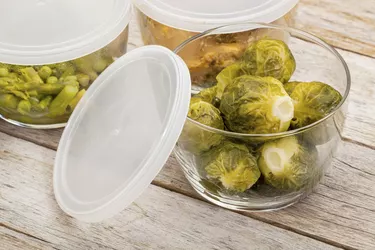
The cost of food keeps rising, and higher prices are affecting more than just restaurant menus. Grocery stores, big box warehouses, movie theaters and even farmer's markets have fallen prey to the heavy burden of inflation. Eating on $10 a day is much tougher than it used to be.
Step 1

Weigh the decision to eat out carefully. For a single person on a budget, eating out is not always the most expensive option. A sub, taco or slice of pizza can cost as little as $2 or $3. This is only a third of your daily food budget, and you don't have to purchase individual ingredients.
Video of the Day
Step 2

Remember the words dry, frozen and canned. Although fresh produce is preferable, foods that are boxed, frozen or canned are usually much cheaper. Ready-made pasta will run you $3-$4, while a box of spaghetti will be about $1. (One box of spaghetti goes a long way.) Canned soups and fruits can be purchased for under $1. Frozen veggies are usually under $2.
Step 3

Toss the breakfast bars and be suspicious of pre-made meals. Sure, bars are easy and convenient in the morning, but a box of five usually runs between $3 and $4. Instead, get healthy with a bundle of bananas at about 39 cents a pound and a tin of dry oatmeal for approximately $1. As for pre-made meals, they are certainly convenient. Be wary of their cost, though. A "Dinner For Two" pre-made package at $9.99 is not a great deal. You might as well go out to a restaurant and spend the extra two dollars to have the food made fresh. However, a $3.99 frozen pizza is economical and usually quite tasty.
Step 4

Scale back on meat. Carnivores hate to hear it, but the truth is, meat is costly and buying it doesn't help you eat on $10 a day. Look for protein substitutes like a carton of eggs for 99 cents or generic brand nuts. Eat meat once a week and only when the grocery stores are offering specials.
Step 5

Say goodbye to brand names. Pennies add up, especially when you're only counting to $10. We've been brainwashed not to believe it, but most off-brand foods are made with the same ingredients of their more popular rivals. It seems like a minor difference when comparing a $1.59 to $1.79, but your food costs will decrease if you bypass the fancy brand.
Step 6

Use your leftovers. Most people make more than enough food when they cook at home. Stretching out beef stew over two meals or microwaving a piece of pizza for lunch the next day will help to lower your food cost.
Tip
Spend approximately $28 on a Brita filtering system for your kitchen sink if you drink a lot of bottled water. This will save you a significant amount of cash over time, especially if you are in the habit of buying $1 and $2 individual bottled waters. Consider replacing coffee with tea. A huge box of tea is a low-price purchase, and tea can perform the same pick-me-up as its more expensive counterpart. There's a reason Happy Hour has such a name. Take advantage. Make a rule for yourself that you'll only drink alcohol if you can land a happy hour special. Your $10 budget will be gone in about a half-hour once you start splurging on expensive drinks.
Video of the Day